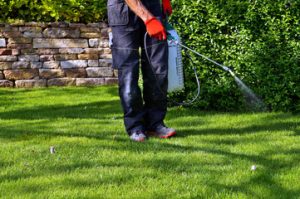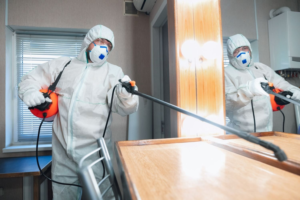Pests can be a serious problem in commercial buildings. They can cause sanitary issues, damage merchandise, and make work spaces uncomfortable for employees.

Threshold levels have been established for most pests, indicating when action is required. This is particularly true in operating rooms and other sterile areas in health care facilities. Contact Pest Control Vero Beach for professional help.
Pest control is an essential part of protecting the health, safety, and property of a homeowner or business owner. While it’s important to deal with a pest infestation once it starts, it’s even better to prevent an infestation in the first place. Using prevention methods, such as regular inspections and proper sanitation practices, can help create a barrier against pests that can lead to expensive repairs and damage.
Prioritizing prevention also reduces the need for more extensive treatments and allows technicians to use environmentally conscious approaches that can minimize the impact on people and the environment. In addition, pest prevention strategies empower customers to take a more active role in the management of their own pest issues.
There are several key preventative measures that can be used to protect against pests, including implementing good sanitation habits, sealing entry points, and keeping outdoor areas clean. Insects and rodents are most attracted to food sources, so ensuring that trash cans are sealed tightly and that discarded food is removed promptly can reduce their attraction. Keeping outdoor areas free of debris and reducing the amount of standing water can also reduce pest activity, as many pests thrive in moist environments.
Other preventative measures that can be used to limit the effectiveness of pests include limiting the accessibility of food in retail establishments, keeping warehouses clean, and using dehumidifiers in damp areas. Providing regular inspections of food production facilities can also help identify potential pest problems early on and provide the necessary treatment before an infestation can occur.
Pests like termites and rodents can cause significant structural damage to homes, as well as contaminate food and threaten human health. In addition to compromising the integrity of buildings, pests can transmit diseases and aggravate conditions such as asthma and allergies. They can also eat away at wood, chew through wires, and destroy insulation. Dealing with a pest problem can be costly, from the cost of repairing the damage to the expense of replacing contaminated food and supplies. Preventative pest control can save money and ensure a comfortable living environment.
Pest Identification
Pest identification is an important first step in any pest control program. It allows for gathering pertinent information such as how the pest feeds, what environmental and harborage conditions it prefers, and other biological clues that can help map out an Integrated Pest Management (IPM) plan to eliminate or reduce the problem without resorting to harmful chemicals.
An initial inspection by trained technicians can reveal evidence of a pest infestation such as droppings, soiled surfaces and other signs of the pest’s activity. This is the key to developing a customized treatment plan to address the pests present in and around your business.
Incorrect pest identification can lead to misguided pest control efforts that may actually make the problem worse. For example, a wood-destroying insect infestation might be addressed by spraying or baiting with products designed for a related species such as a termite. This would likely be an error as the pests have very different behavior patterns and require very specific control methods.
Another critical component of accurate pest identification is evaluating the condition that caused the problem to begin with. It is often easy to jump to the conclusion that a pest is responsible for damage when in reality non-living factors like weather extremes, air pollutants or soil conditions were more to blame.
Pests can pose health and safety risks, as well as financial consequences for a business. Some of these include a threat to human health, as with wasps, bees and cluster flies; a risk to property, as with rodents, clothes moths and cockroaches; or a potential loss of income as with bed bugs.
Routine pest control will prevent these risks and protect your business from costly damage to buildings, stock and equipment. It can also keep local authorities from shutting down your business on health and safety grounds, which could be disastrous for any type of company.
In addition, many pests carry pathogens and allergens that can cause sickness in humans and pets. Other pests such as earwigs, pillbugs, springtails and silverfish can damage books, papers and other organic materials while wood-boring pests such as termites, carpenter bees and hornets can destroy the structural integrity of your building. Regularly scheduled pest control will prevent these types of problems and keep your property value high.
Treatment Options
Once pests have been identified, it is important to choose a treatment option that is best suited for the situation. Treatment options are usually grouped into biological, chemical, cultural or physical control methods.
These include natural controls, which are environmental factors that limit pest populations and make the environment less hospitable; biological controls, such as introducing natural predators or parasites to control pests; and cultural controls, which alter the conditions necessary to support pest populations. Pesticides are also used to control pests. These are substances that can be applied directly to pests or their food sources, and include herbicides, insecticides, fungicides and rodenticides. Some chemical pesticides are organic and do not cause harm to other organisms, but they still pose a risk of toxicity to humans, animals, plants or the environment.
Taking a preventative approach to pest control is the best way to avoid a pest infestation, but sometimes it’s necessary to take reactive measures in order to control existing problems. The first step in any treatment is to identify the source of the problem, and this may involve sealing entry holes or removing infested materials. Other treatment options may involve baiting, dusting or spraying.
A variety of natural products can be used as a pest control method, including baking soda, which works by disrupting the digestive system of insects and by killing larvae in standing pools of water. Neem oil is another natural pesticide that can be diluted and sprayed around potential nesting areas to deter a wide range of bugs.
Choosing the right natural pest control product is important as it can help to minimize exposure to chemicals and reduce the amount of toxic materials in the environment. The most effective pest control products will be tailored to your specific needs and the conditions surrounding them, but should always be evaluated for their level of toxicity, environmental impact and effectiveness.
Safety
Identifying the pest is an important part of pest control because it allows you to develop appropriate treatment methods. Look for physical traits like shape, size and color; note behavioral patterns; and pay attention to environmental influences that can help you zero-in on your pest. There are online pest identification resources that can be used to compare your findings with pictures and descriptions, which can make this process easier.
Inspecting the property for pest infestations is also an essential step in pest control. Thorough inspections can reveal entry points, nesting areas, and other influences that contribute to pest attraction and growth. This information is crucial for preventative measures that can eliminate the pests before they become a problem, such as sealing entry points and eliminating food sources and water sources.
Pesticides aren’t always necessary for pest management, but when they are, it is essential to practice safe chemical handling and use. This includes reading and following the product label for all applications, including mixing, application, storage and disposal. Wearing personal protective equipment (PPE) like gloves, goggles and respirators based on the product’s toxicity level is also essential to reduce risk. It is also important to keep first aid supplies, emergency contacts and spill kits readily available, and to dispose of chemicals in accordance with label instructions.
Routine pest control can preserve the value of your property, preventing damage to structures and furniture and protecting sensitive items like electronics and artwork from chemical exposure. Keeping pests away can also save money on costly repairs and replacements.
Effective pest management involves a balance of treatment strategies with a strong focus on prevention. Applying Integrated Pest Management (IPM) techniques and staying current with certifications allows professionals to deliver treatments that are safe for people, pets and the environment. These practices support responsible environmental care and help ensure regulatory compliance. To achieve the best results, it is critical to follow the IPM approach, which prioritizes non-chemical and low-toxicity pest controls when possible. This helps to avoid overuse of pesticides and minimize the impact on natural ecosystems.
